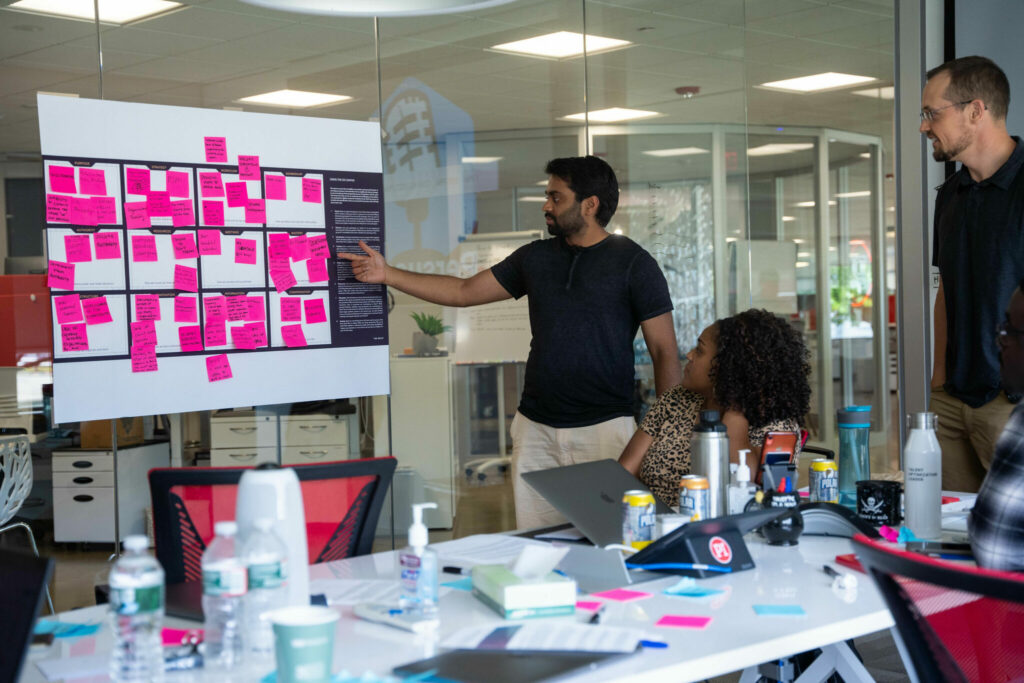Maybe you’ve seen them working diligently in other departments. Or maybe you’ve been lucky enough to be a part of one yourself. Whatever the case, you’re likely aware of the power of a highly effective team. These teams seem to anticipate what each person – and the business as a whole – needs. They support each other at every step, uncovering creative solutions to tough challenges, and they often make it look easy.
These teams can seem like their members were hand-picked specifically for each job. But the reality is that the most high-performing teams are rarely built from scratch – rather, they’re developed. Instead of simply assembling qualified people and expecting them to be productive right out the gate, you need to know how to nurture them. That means understanding individual talents and working styles, but also the science behind team dynamics and discovery. It’s about figuring out how they collectively best work together, to foster and nourish a culture of success.
A personalized leadership approach for each team member.
PI’s behavioral insights help leaders inspire and coach each employee in a way they truly connect with.
It’s a process, and an investment, but one that ultimately rewards you with a team that is more productive, independent, and resilient. Let’s dive into the details.
The key benefits of team development
Successfully molding a team from a collection of individuals into a well-oiled machine can take tons of time and effort. Although it may feel daunting at first, this work can pay off months or even years into the future, enabling organizational growth. Here are just a few of those longer-term benefits:
- Improved teamwork: Most obviously, an investment in team development is going to produce a more cohesive, communicative, and collaborative group. The team will have access to a wider range of strategies for solving problems, resolving conflict, and supporting each other at every step.
- Better productivity: Getting your team to produce more is rarely about driving them harder or working them longer. Instead, you’ll almost always get better results when you teach them strategies for working together. This will naturally lead to great efficiency and improved productivity.
- Increased innovation: When everyone on a team is comfortable working together, they’ll be more inclined to share their ideas and take risks. This can lead to new and more creative insights you might not get from a team that doesn’t work together as well.
- More engagement: There are a lot of tips out there for getting employees to contribute more and show greater interest in their job, but none are as effective as simply getting the team around them to run more smoothly. When people can see how their efforts, as well as those around them, contribute to success, they’ll be much more likely to stay engaged.
- High job satisfaction: Add up all the above – an improved collaborative process, a higher rate of productivity, and an environment where it’s easy to share ideas and stay engaged – and the result is going to be employees who are happier to be on the job.
Stages of team development
Properly developing a team takes time. This is natural – after all, a team is built on relationships, and healthy relationships don’t form overnight. Still, it can feel frustrating if you aren’t seeing tangible results. During these times, it can be useful to be familiar with the different stages of team development.
Originally formulated by psychologist Bruce Tuckman, the following framework can help you properly evaluate how your team is developing:
- Stage 1: Forming: During this initial stage, team members are getting to know each other and become familiar with the team’s goals. People may be excited and hopeful, but they may also be anxious or uncertain about the team’s future. Expect lots of questions during this stage.
- Stage 2: Storming: As the initial excitement wears off, team members during this stage may begin to realize they need to adjust their expectations. Frustrations can arise, especially as more people express their individuality and voice their concerns. Challenges to the leader’s authority may even occur as well. Getting through this stage is crucial for success.
- Stage 3: Norming: At this point, team members begin to resolve their conflicts, establish norms, and develop a sense of cohesion. They should start to accept one another and become more flexible and inclusive. As distinct roles and responsibilities emerge, a greater sense of teamwork and collaboration emerges.
- Stage 4: Performing: This stage represents the highest performing level for the team. Everyone is aware of each other’s strengths and weaknesses, has a clear sense of the team’s goals, and is able to work together effectively to solve challenges. Trust and open communication are strong, and each team member is capable of making decisions on their own.

The role of leadership in team development
Obviously, when it comes to forming a successful team, a whole lot depends on its individual members. They must be open-minded, willing to work together, and flexible enough to adapt to different styles of communication. But even the most collaborative teams still need a strong leader to guide them toward cohesion. This makes leaders the most important aspect of team development.
Developing a team begins when a leader sets the tone for how everyone will work together. First and foremost, this involves building and establishing trust. You can do this by emphasizing how important it is for the team to communicate openly, honestly, and transparently. Set an example by making sure everyone understands their goals and responsibilities, as well as any upcoming challenges. Take a step further toward fostering a culture of honesty by always answering questions and remaining open to criticisms, even when you may disagree.
Building trust can also be done by establishing a safe and inclusive environment. Properly known as “psychological safety,” this is when everyone feels comfortable expressing their opinions, sharing their ideas, and taking risks. You can help set this in stone by actively involving everyone in decisions and encouraging their input. No matter what, be sure to show that you value their ideas. And be sure to discourage unconstructive criticism or gatekeeping of any kind.
Empowering team members is another important way leaders can develop their team. After all, the goal is to not only get them to work seamlessly together, but also grow in their roles and take on more responsibility. You can do this by building on the trust you’ve established and delegating tasks to different people based on their strengths and capabilities. This is a great way of not only distributing the workload, but also challenging team members to learn new skills they might not otherwise.
This is just the beginning of what a team leader should do – but these steps are vital. By establishing trust and encouraging team members to grow, you can help set the whole team up for successful development.
Building an effective team the right way
So what’s it actually take to create a successful, high-performing team? While the particularities will depend on the individual characteristics and experiences of each person, the following is a general guide you can use to bring out the best in your team. Just remember to be patient. It can take time and effort to turn a group of people into an effective team – but it will be well worth it.
Get to know individual strengths and weaknesses.
It will be difficult to properly develop your team if you don’t first have a good lay of the land. That means getting to know what everyone is good at, both within their defined role and outside of it, as well as what they could use help with.
An easy way to do this is to ask everyone to conduct a self-assessment. Get them to write down their own strengths and weaknesses, then use this as a guide while you begin working with them. This should give you a good basis to begin figuring out how best to delegate tasks, assign resources, and support your team.
Make positivity a staple of the workplace.
Even in the best jobs, even when you love what you do, work can be stressful. Deadlines might loom, goals might be missed, clients might be unreasonable. All this makes it important that your team is a place of positivity. If you can get your employees to look forward to taking on challenges together, they’ll be better equipped to deal with disappointment and transform it into team success.
Get this going by practicing positivity yourself. Make a concerted effort to recognize wins each week and single out individuals for their contributions. And don’t let setbacks dampen the mood. See them as learning opportunities for your team, rather than mistakes that deserve punishment. This is the best way to help everyone with their personal development.
Foster a culture of continuous improvement.
There shouldn’t be an end goal to your team’s development. Instead, by getting them to think of their development as a continuous process, rather than a more linear journey, you can help keep them more aware of their shortcomings so that they’ll stay prepared and flexible in the face of new challenges.
Do this by making reflection and analysis a regular part of the work process. After each project is completed or milestone met, check in with team members and encourage them to identify places they could become more efficient. Get everyone to find something they could be better at, then provide them with the necessary resources and support to make tangible improvements. Whether this is additional training, mentorships, or access to outside workshops, the encouragement you give toward their development will show you value their individual success.
Reward collaboration and knowledge-sharing.
Collaboration should not only happen frequently within your team – it should be a natural instinct. Unfortunately, for many people, it is often the opposite. They may think it’s easier or faster to simply get the job done themselves, rather than reaching out to someone else. But by rewarding collaborative efforts, as well as recognizing when sharing knowledge has benefited the team, you can help your employees avoid their worst impulses.
Often, you’ll need to do little more than simply call out when different team members have worked together well. Bring up their example during team meetings, or single them out in team messages. Make a special effort to do this when the collaboration is cross-departmental. That kind of novel knowledge sharing can often lead to unexpected benefits.
Give and receive feedback equally.
Finally, make feedback a pillar of your team. Give each team member regular reviews in which you go over what they’ve done well and what they could improve, then open it up to them. Give them the opportunity to tell you how you’re doing in your role as leader. Or, if they aren’t comfortable telling you in person, send out a survey in which they can offer their feedback anonymously.
However you receive it, make sure you listen to these criticisms and make an honest effort to learn from them. This will not only show that you value what they have to say, but encourage a more open and healthy dialogue – a key ingredient to long-term team development.








